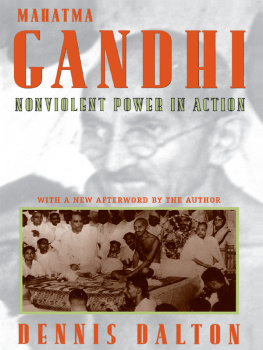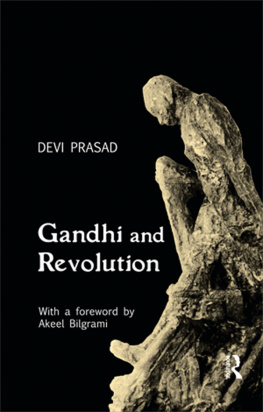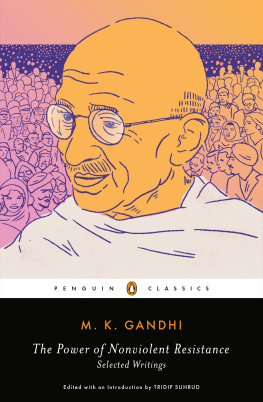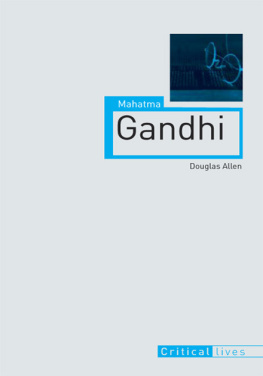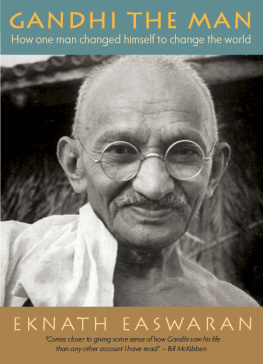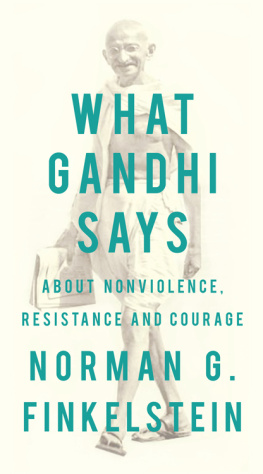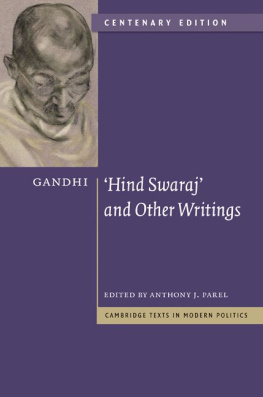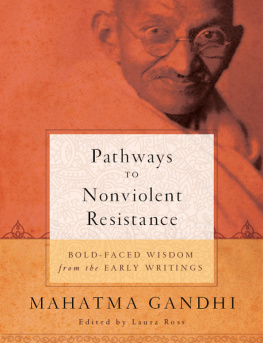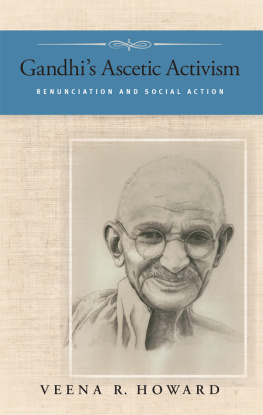MAHATMA
GANDHI
MAHATMA
GANDHI
Nonviolent Power in Action
Dennis Dalton
WITH A NEW PREFACE, AFTERWORD,
AND CHRONOLOGY BY THE AUTHOR
COLUMBIA UNIVERSITY PRESS NEW YORK
COLUMBIA UNIVERSITY PRESS
Publishers Since 1893
New York Chichester, West Sussex
cup.columbia.edu
Copyright 1993, 2012 Columbia University Press
Preface copyright 2000 Dennis Dalton
All rights reserved
E-ISBN 978-0-231-53039-2
Library of Congress Cataloging-in-Publication Data
Dalton, Dennis.
Mahatma Gandhi : nonviolent power in action / Dennis Dalton.
p. cm.
Reprint of 1993 edition. Includes new preface, afterword, and chronology.
Includes bibliographical references and index.
ISBN 978-0-231-15958-6 (cloth : alk. paper)ISBN 978-0-231-15959-3 (pbk. : alk. paper)ISBN 978-0-231-53039-2 (e-book)
1. Gandhi, Mahatma, 18691948. 2. StatesmenIndiaBiography. 3. NationalistsIndiaBiography. I. Title.
DS481.G3D215 2012
954.03092dc23
[B]
2011029531
A Columbia University Press E-book.
CUP would be pleased to hear about your reading experience with this e-book at .
Photographs of Gandhi and letters were provided by Pyarelal Nayar and S. K. De, then director of the Gandhi Memorial Museum and Library, Rajghat, New Dehli. Special thanks to Pyarelal for his detailed comments on and dating of these photos. Photographs of Lord Edward Irwin and Reginald Reynolds were provided by the Nehru Memorial Museum and Library, New Delhi. Photographs of Gangabehn and Ramjibhai Badhia were donated by Mr. Arjubhai Badhia.
References to Internet Web sites (URLs) were accurate at the time of writing. Neither the author nor Columbia University Press is responsible for URLs that may have expired or changed since the manuscript was prepared.
CONTENTS
1. Satyagraha Meets Swaraj:
The Development of Gandhis Ideas, 18961917
3. Critiques of Gandhi from His Contemporaries:
Rabindranath Tagore and M. N. Roy
For my students, with thanks.
And to remember those
courageous and powerful few
who marched to Dandi
in pursuit of freedom.
A variety of incidents in my life have conspired to bring me in close contact with people of many creeds and many communities, and my experience with all of them warrants the statement that I have known no distinction between relatives and strangers, countrymen and foreigners, white and colored, Hindus and Indians of other faiths, whether Muslims, Parsis, Christians or Jews. I may say that my heart has been incapable of making any such distinctions.
Gandhi
The power of nonviolent action has been demonstrated amply throughout the world since the second edition of this book in 2000. In that year, nonviolent power succeeded dramatically in Eastern Europe, employed by student groups like OTPOR in Belgrade to oust Slobodan Milosevic. But the most striking evidence came in the Middle East, where activists led nonviolent mass action against the longstanding authoritarian regimes of Zin El Abidine Ben Ali in Tunisia and Hosni Mubarak in Egypt. As the world watched and worried in early 2011 that these revolts would degenerate into violence, nonviolent power quickly deposed the despots. Pundits on both the left and right failed to anticipate the success of soft power against these entrenched governments; if considered at all, nonviolent action was quickly discounted as impotent.
The most notable exception to these skeptics is the American political theorist Gene Sharp. Against arguments that dictators like Milosevic and Mubarak were impervious to the power of nonviolence, Sharp has consistently and cogently expounded strategies to overcome them. Since Sharp published Gandhi Wields the Weapon of Moral Power in 1960, he has steadfastly promulgated his theories (in works noted in the afterword). OTPOR activists in Serbia and protesters in Cairo have openly acknowledged their intellectual debt to Sharps strategies for using mass nonviolent resistance to replace dictatorships with democracies.
Thus the idea of nonviolence has continued to circle the globe in improbable ways. From its origins in all of the great world religions, most significantly in the Hindu idea of ahimsa and Christs Sermon on the Mount, it has leaped centuries to the interpretations of Thoreau and Tolstoy, to Gandhis breakthrough in South Africa, and to the works of Martin Luther King Jr. and Gene Sharp in the United States. These are only a few obvious examples. Hundreds of writers have perpetuated the idea; millions have marched to bring it to life. Among all who have either theorized about this phenomenon or actively participated in civil disobedience against unjust authority, Gandhis thought and leadership are unquestionably the most prominent.
Harold Laski, an eminent English political theorist and citizen of the empire that Gandhi was then in the process of overturning, observed when Gandhi arrived in London for the last time: No living man has, either by precept or example, influenced so vast a number of people in so direct and profound a way. This has also been the judgment of history if we compare Gandhis enduring relevance to that of all the other leaders of major mass movementsviolent without exceptionduring the twentieth century. Gandhis claim to uniqueness rests both on the originality of his thinking about power and even more on his uncanny ability to put his theory into practice. Nonviolent power in action defined his career: the creative ways that he used it excite the world today. We can see human events, if only for a moment, through the lens that Gandhi above all others provided, without a bias toward the power of violence.
The aim of this study is to explain and understand the genius of Gandhis singular achievement. Although the book recounts, especially in the third chapter, extensive criticism of Gandhis leadership by his Indian contemporaries, I write for the most part with a strong sympathy for my subject. Most of the book is given to two lengthy case histories of his exercise of power: the mass civil disobedience campaign of 1930 and his fast for Hindu-Muslim unity in 1947. I chose these examples to show Gandhi at his best, using power strategically and wisely. In each case, the dramatic force of nonviolent power is highlighted because this is the purpose of the book: to offer lucid examples of how Gandhi connected his aim of liberation with the methods of nonviolent action.
As I have emphasized in the afterword, from the time that I arrived in India in 1960, I was fortunate to connect with Pyarelal and Sushila Nayar, the brother-sister team that served as Gandhis personal secretary and physician, respectively. They were a remarkable pair of instructors, discussing in detail my questions and doubts about Gandhi, never turning away my queries about his personal and political life, whether concerning his conduct on the famous salt march (where Pyarelal was at his side) or matters of his health and diet. During the subsequent decades that I corresponded with both of them, in India and from London and New York, we exchanged manuscripts, including the ten-volume biography that they wrote together and the chapters of this book.
I will mention, after the Nayars, only a few of the many other Indian friends who provided me with their remarkable insights into Gandhi. First and foremost is S. R. Mehrotra, who from the beginning of my graduate studies in 1962 at the School of Oriental and African Studies (SOAS), University of London, guided me through the labyrinth of the old India Office Library files, explaining and interpreting records of the Raj in laborious detail. His awesome knowledge of the Indian National Congress has since been published; his recent discoveries behind Gandhis writing of

